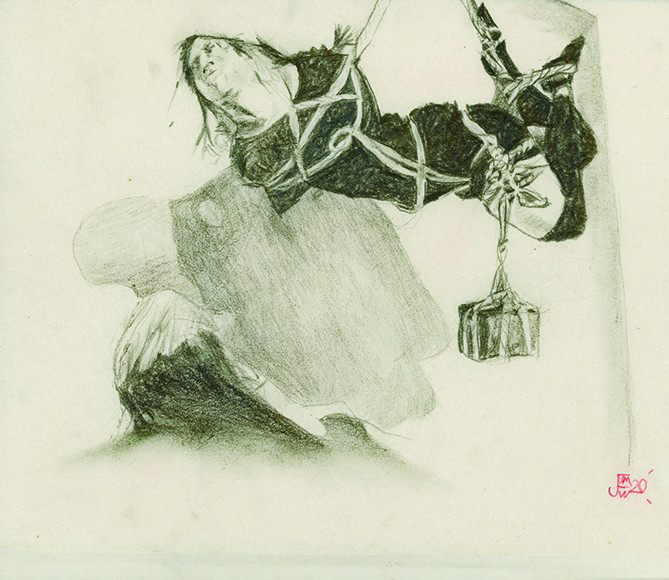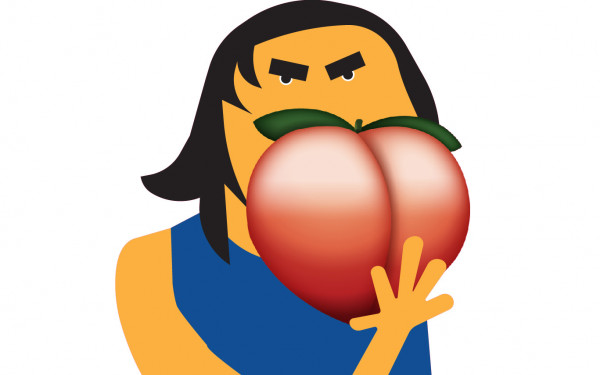Sex Ed(itorial): Tie Me Up so I Can Let Go
The Art of Shibari Builds Trust, Intimacy, and Relief
Sprinkle (their kink name) is hanging from a beam, wrapped in elaborate ropes, a small cinder block hanging from their thigh.
Sprinkle is suspended by the ropes embracing their chest and arms, round their neck, down to their thighs, feet, and through their hair. The cinder block hanging from their thigh serves as extra weight, for additional torture.
Sprinkle is a rope bottom, or rope bunny, who practices shibari. When their back starts to hurt, their top, Dante, gently lets them down. Once they’re untied, Dante and Sprinkle hug and share a tender moment, revelling in their intimacy.
Shibari is the art of Japanese rope bondage. Beginning in the thirteenth century, hojojutsu, rope tying, was used to restrain and punish prisoners. It evolved to kinbaku as an erotic art. Kinbaku-bi (緊縛美) translates to “the beauty of binding tightly.”
Kinbaku was dubbed shibari as it moved to the Western world and means “to tie.” Riggers, or rope tops, spend years studying the rope as someone would study a martial art: perfecting the art of their ties and forms, both for aesthetics and safety.
Sprinkle had a lot of issues with sexual repression due to their upbringing, so they took no conscious interest in heteronormative sexuality.
But, on a subconscious level, they had taken interest in kink and bondage, domination, sadism, and masochism in ways that didn’t include penetrative sex.
While studying in Japan, Sprinkle was exposed to erotic gore art, which often involved torture scenes with people tied up.
From there they found some videos online of people doing shibari and said the intimacy shared between the rigger and bottom was unlike anything they’d ever seen. They added it doesn’t always have to be sexual, either.
“There are so many other ways we can be intimate within kink as a whole, but I loved rope, I loved being wrapped up in someone’s affection, knowing that the rigger has your best interests at heart and is paying complete attention to your reactions,” they said.
“I love the combination of pain and affection, the kind of meditation that comes from being held in an uncomfortable suspension but working through it mentally, pushing my pain limits, mixing torture like impact play, biting, wax, needles with the sweet comfort of being touched and held and kissed.”
Dante is a highly skilled rope top and their full-time job is tying people. It’s a form of sex work, but without traditional sexual elements. Their interest in romance and sexual chemistry is different with everyone, but they mainly play platonically.
“You are sitting with them to offer your time to someone—even if it has nothing to do with genitals, it is still intimacy in a way,” they said.
“When people say it’s inherently sexual, they mean that the play is emotional to them. Obviously sex can be part of it, but usually Japanese bondage is more like foreplay.”
They say the way they tie is platonic because intentions are vocalized clearly and they won’t touch people in ways that would make them feel like sexual prey.
“I touch to reassure and encourage the person to relax. So, the focus is entirely on them,” they said.
Dante used to be willing to provide a trial for people, but not everyone likes it, “and it’s fair,” they said. But, as they don’t need new partners, having people try rope is labour.
When they are paid, they are able to enter a better headspace, without feeling like people are taking their energy for granted, and are willing to put their expertise to use.
“When I top, I give attention, and when I bottom, I receive attention. To me the difference is like being spoiled versus spoiling someone.”
—Dante
“When I start with someone new, it’s not as comfortable at first because the trust needs to be built on both sides,” they said. “So if I tie someone once just for them, I don’t really have fun. I can’t play with risk; I’m just offering care.”
There is a lot of stigma surrounding shibari and BDSM as a whole, though the practice has crept into mainstream culture.
Dante said people either believe shibari is much easier than it actually is or, conversely, that it is terrible, violent, and dangerous.
For those who practice it, though, it involves a deep sense of intimacy. Restriction doesn’t just have to do with rope on the body, it also has to do with the psychological state of having no control over your situation and complete trust in your partner. It’s about release.
“When I top, I give attention, and when I bottom, I receive attention. To me the difference is like being spoiled versus spoiling someone. Both are fun,” said Dante.
“That said, everyone has different reasons for trying shibari. Sometimes it can be to reaffirm consent, to move on from a negative experience.
Or because, as a woman, getting tied by a man feels like we’re supposed to please him, so paying for that service can be very liberating as a form of self-care,” they added.
Though shibari involves pain, it isn’t always sadistic.
People’s experience and resistance to physical challenge and pain are all different, and a good rope is a rope that matches the intentions and mood of those involved.
Sprinkle finds themselves lucky to have found Dante right away as there are rope riggers out there who don’t always practice safely or with the right intentions.
Dante always has discussions to make sure the bottom gets what they need.
They will reach out the next day to ask what can be improved, how they feel, and what made them sore.
There’s also a discussion prior to play where they are upfront about the risks involved.
But, Sprinkle said, shibari ties and forms have been developed to become much more conscious of possible bodily harm and how to avoid it.
The ties are made to sit in ways that avoid the possibility of causing nerve damage or other long-term harm.
Shibari appreciates the contrast between the body and ropes, the way flesh sits against rope, the curves of bodies, and the intricacies of knots, with very specific traditions and tying methods.
“I like to tie pretty things so you feel pretty. If you feel good and you let go, that’s what I find pretty.
There’s some aspect of symmetry and beautiful shapes, but the real beauty is emotions,” said Dante.
“If someone just ties pretty things, but there’s no emotion in it, I’m not interested in looking at it.”


_600_832_s.png)




